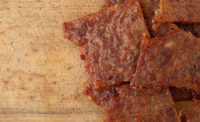More Than a Feeling
By Andy Hanacek, executive editor
Steakhouses continue to use the bread-and-butter combination of high-quality beef, superb service and enticing ambiance to fly high despite a slower economy.
It’s time to celebrate. And guess where the meal will be held? If this exchange is typical of most consumer restaurant decisions, the party will move to the confines of a high-end steakhouse, where the old adage, “You get what you pay for,” apparently holds true in the minds of the consumer.
“[Steak is] an affordable luxury,” explains Chad Mackay, president and COO of Mackay Restaurant Management Group, which owns the El Gaucho chain in the Pacific Northwest. “Even if you’re not wealthy, it’s celebratory, and we don’t see that changing.”
Mark Polzer, vice president of business development with Certified Angus Beef, concurs, saying steakhouses have remained committed to serving a high-quality product and ambiance, which reverberates well with consumers looking for that type of service.
“I think there is that expectation that if it’s that high-quality atmosphere [and] more expensive menu, that that’s what you’re gonna get,” he says. “The nice thing is, most [consumers] know what they’re going to get. The reality is, because of the pricing on the menus, typically we’ve not seen as many of the restaurants in this segment cutting corners on quality as you might see in other foodservice areas.”
Because of this, it is the steakhouse industry that should be celebrating, particularly given the rough ride most in the foodservice industry have experienced lately, according to Polzer.
“The good news is, if you’re reading same-store sales numbers for restaurant businesses, the family-casual dining segment — the Applebee’s and Chili’s of the world — are really struggling over the last year and a half,” he explains. “Their same-store customer counts coming through the door are at best a push from the previous year.
“We’ve not seen any kind of erosion [in sales numbers] with those upscale steakhouses,” he adds. “They continue to do extremely well, despite the fact that there are more and more opening.”
Indeed, by sticking to their core consumers’ wishes, steakhouses have, thus far, weathered tough economic times recently. Having come through this stretch relatively unscathed, steakhouses appear to be headed for further success, Polzer says.
“It almost reminds me of 30-35 years ago, when the pizza craze hit and they couldn’t build pizza places fast enough. Everyone said, ‘This is a fad and it will go away,’ and obviously pizza is not going away,” Polzer says. “I would contend that there will always be a very strong upscale steakhouse segment. This has been going on for 10 years or more now, that we’ve seen tremendous increases in dollars spent there.”
According to statistics from “2006 Beef Volumetrics in Foodservice,” a study conducted annually for The Beef Checkoff by Technomic, Inc., steak sales in the foodservice arena increased 68 million pounds to 1.41 billion pounds annually in 2006. That breaks down to 831 million pounds sold in commercial foodservice operations and 575 million pounds in non-commercial areas.
One positive wild card fueling this growth has been the opening of new restaurants committed to quality — particularly those backed by recognizable names, says Jane Gibson, executive director, Foodservice Marketing, working on behalf of the Beef Checkoff Program.
“Steakhouse growth seems to have been spawned by notable chefs investing their talents and resources in upscale steakhouse venues — David Burke’s ‘Prime House’ in Chicago, Michael Lamonico’s ‘Porterhouse’ in New York City, to name a few,” Gibson explains. “In addition, there are a number of professional athletes with steakhouse brands — Don Shula, John Elway and Michael Jordan. But, ultimately, these businesses are driven by an emphasis on food quality, service, and their ability to provide a unique experience for which the consumer is willing to pay more.”
Living the high life
Being willing to pay more for the finer things in life is one thing, but even high-end steakhouse restaurateurs understand that it’s not just about serving the beef. Peter Bozzo, vice president of Chicago Meat Authority, which supplies several high-end steakhouses with its fine cuts, puts on his consumer hat and sums it up easily when he says, “I always choose restaurants based on ambiance, especially when deciding to spend an extra amount of money on dining.”
It’s the ambiance, the atmosphere, the experience that brings customers to steakhouses’ doors. They want more for the money they’re about to spend — and the successful establishments have that on their mind constantly. El Gaucho, for example, was designed around making the experience an unforgettable, enjoyable time — not just a time to sit down, shell out big bucks for a hunk of beef and go home. It’s a time to live the high life, in a sense.
“The core is, you have to have the best products, whether it’s your wine list, liquor, food, beef and seafood programs. They just have to be the best you can find,” Mackay describes of his flagship chain. “But that doesn’t cut it — that’s not enough. You have to take service and atmosphere to the next level. An excellently trained service staff that is not pretentious and is genuine with warm hospitality [is important], so when you call to make a reservation, you feel as though the person on the other end is actually smiling … rather than feeling like you’re a burden to them.”
Those two legs of the stool, as Mackay explains, still can’t stand alone — the third leg is the ambiance and atmosphere of the establishment.
“[It’s] the lighting, the smells, how the room feels, the music and the hustle and bustle of things happening,” he says. “We absolutely believe that a great steak alone doesn’t really cut it alone anymore.”
Making the cut
Although steakhouses are flying high, giving customers that great experience, backed by great steak and great service, groups such as The Beef Checkoff and Certified Angus Beef, among others, are looking to new muscle groups, cuts, preparation methods and flavor profiles to spice things up and keep customers coming back.
Once such cut that has found success not only in steakhouses but also in other foodservice segments, is one that was introduced by The Beef Checkoff recently — the Flat Iron. Indeed, this tender, tasty cut from the shoulder of the cattle has done well, having outsold both T-bone and Porterhouse steaks across all of foodservice in 2006, according to the “2006 Beef Volumetrics in Foodservice” study. Gibson says that the Flat Iron and the Petite Tender, another innovative cut introduced by The Beef Checkoff, have gotten the most buzz lately.
“Both are relatively small in size, compared to the more traditional steak cuts, making them completely compatible with current menu trends that include unique/differentiating steak entrees, small plates, upscale salads and sandwiches,” she says. “In addition, the new cuts have expanded the steak category, providing more menu options and price points for foodservice operators, and more steak choices for consumers.”
But innovation in steak is not limited to across-the-board options for low- to mid-range steakhouses and other foodservice categories. In high-end steakhouses, innovation may come slowly, Polzer says, but it is always on the minds of operators.
“I think the mindset of the [high-end steakhouse] operator and the patron coming into the restaurant is, ‘If I’m going to slap down $45 for a steak, I want a T-bone or 16-ounce strip steak,’” he says. “So they tend to be a lot less adventuresome when it comes to menu selections.
“I do think as beef supplies continue to try to keep up with demand in this segment, operators will get more adventuresome. They’ll look at the teres major, that shoulder tender; they’ll look at the Flat Iron; they’ll do more things. In fact, they’re doing more now with the center-cut, top sirloin steak.”
Mackay says innovation also can come in the form of taking an already high-quality piece of beef and applying the right aging process and cutting technique to produce a unique dish.
“We were able to produce a baseball-cut sirloin that is incredible — a piece of meat that people wouldn’t normally associate with money and indulgence,” he says. “Typical consumers would not normally pick up a sirloin and think that was the pinnacle of steaks. But because [sirloins are] so big, and we push them to 35 days on the aging process and then break that down to the baseball cut, it creates a sirloin that just eats like a Filet Mignon.”
Yet, a baseball-cut, dry-aged, unique sirloin is not something just any steakhouse operator can jump on and succeed in doing so, Mackay adds. The dedication of the operator — especially financially — and the restaurant staff is important in the process.
“With something like the baseball-cut sirloin, automatically, just the fact that we do the dry-aging on it and use that center portion, it’s unique — there are not a lot of operators who will go there. … Obviously, people can copy it, but they still have to do it — it’s an expensive process, and you have to be able to sell them and move them.”
Indeed, many operators don’t have such a value-added product within their reach, as El Gaucho restaurants do. But with the way the clamor for steakhouses has risen over the past decade and continues to rise, there may be plenty of room for steakhouses of all varieties, sizes and attractions to keep consumers happy.
And being happy is what steakhouses are all about for consumers. Just ask anyone who runs a steakhouse, such as Mackay.
“The reality is, and it always has been since my dad started this business 45 years ago, that when people want to celebrate, they want a steak,” he concludes. “And that’s never changed.”



Report Abusive Comment